|
“Sir, sir” a woman called out the following day, nearly colliding with sergeant Vlas who was rushing to catch his train. “It was beautiful last night, wasn't it? What wonderful slides!”. And she wasn’t the only one who thought so. All were talking about the meeting, their words full of praise. The pictures were so magnificent and so large. A diameter of 7 metres made a big impression, even in the Trade Hall. The enthusiasm of the public of Rotterdam found a lively expression in the approval given to the slides and the accompanying lecturing. The various portraits of our leaders, besides those of our Queens, were heartily applauded. The strange views from faraway countries and a few stories accompanied by songs did very well indeed. However, the story of Silvo or the destruction of Terradelphia, topped everything. Its beautiful imagery was admired and great attention was paid to the history which was interspersed by hymns. |
||
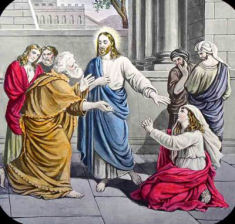 The
Salvation Army in the Netherlands often made well use of the magic lantern in various ways. It was
mobilised in numerous demonstrations and meetings. Slide series drew attention
to the Army’s social work and causes, besides providing entertainment with
adventurous and comic slides and information with portraits of famous Dutch
people and views from other countries. Many stories intend to be a warning
against the abuse of alcohol, gambling, moral corruption and waste of money. The
Salvation Army in the Netherlands often made well use of the magic lantern in various ways. It was
mobilised in numerous demonstrations and meetings. Slide series drew attention
to the Army’s social work and causes, besides providing entertainment with
adventurous and comic slides and information with portraits of famous Dutch
people and views from other countries. Many stories intend to be a warning
against the abuse of alcohol, gambling, moral corruption and waste of money.The English Salvation Army Soldier Matthews yearly visited the Netherlands between 1896 and 1900. Matthews was internationally well known because of his explorations in Africa where he travelled with David Livingstone. Annually Matthews travelled throughout the whole of the Netherlands with his lantern shows, using his triple magic lantern, an impressive device provided with some gas lamps. The Army’s magazine ‘De Oorlogskreet (War Cry) announced his arrival on 15th of February 1896 as follows: |
||
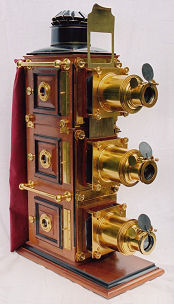 Sir Matthews will make a tour around our country with his
fabulous lantern, starting in Rotterdam and Den Haag (The Hague). With his large
lime light lantern he will give presentations showing all sections of our work;
such as the Land colonies, the City colonies, the rescue homes, the slums and
the homes for alcoholics and former drunkards. Furthermore, he will show views
from other countries and huge slides (with lime light), larger then anyone in
the Netherlands has ever seen before. He will bring a series of 150 to 200
slides, projecting the images on a screen the size of 50 to 100 square meters.
His lantern is one of the biggest in the world and the beautiful slides arouse
the amazement of both poor and rich. Sir Matthews is an important person. He is
60 years old and a member of the Royal Geographical Society in England, thus a
man of scientific merit. Besides being a veteran of the famous trenches of the
Sedan and the Crimean War, in which he was shot and on several occasions barely
escaped death. Sir Matthews will make a tour around our country with his
fabulous lantern, starting in Rotterdam and Den Haag (The Hague). With his large
lime light lantern he will give presentations showing all sections of our work;
such as the Land colonies, the City colonies, the rescue homes, the slums and
the homes for alcoholics and former drunkards. Furthermore, he will show views
from other countries and huge slides (with lime light), larger then anyone in
the Netherlands has ever seen before. He will bring a series of 150 to 200
slides, projecting the images on a screen the size of 50 to 100 square meters.
His lantern is one of the biggest in the world and the beautiful slides arouse
the amazement of both poor and rich. Sir Matthews is an important person. He is
60 years old and a member of the Royal Geographical Society in England, thus a
man of scientific merit. Besides being a veteran of the famous trenches of the
Sedan and the Crimean War, in which he was shot and on several occasions barely
escaped death.Wherever Matthews ventured he attracted full houses. The reviews were full of enthusiasm, as is clear from this Rotterdam newspaper report: |
||
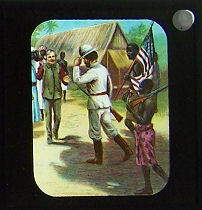 Tonight a vast crowd made its way to the Algemeen Verkooplokaal
(the General Trade Hall.) to attend a social
meeting of the Salvation Army. After singing a few hymns, the
presentation of lantern slides followed. A screen, circa 20 square foot in size, was
erected on the stage. Sir Matthews, who accompanied
Livingstone on his travels
through Africa, took charge of the lantern presentation and was served by the
world’s largest Lantern. Various branches of social work were
illustrated by limelight, among them portraits of several officers, images from
City and Country Colonies, intemperance scenes, charity work in the slums,
rescue work and nursing activities. This
clearly touched the heart of the audience, encouraged by the moving way of
chanting hymns in the half-lit hall, where an astounding silence reigned. Tonight a vast crowd made its way to the Algemeen Verkooplokaal
(the General Trade Hall.) to attend a social
meeting of the Salvation Army. After singing a few hymns, the
presentation of lantern slides followed. A screen, circa 20 square foot in size, was
erected on the stage. Sir Matthews, who accompanied
Livingstone on his travels
through Africa, took charge of the lantern presentation and was served by the
world’s largest Lantern. Various branches of social work were
illustrated by limelight, among them portraits of several officers, images from
City and Country Colonies, intemperance scenes, charity work in the slums,
rescue work and nursing activities. This
clearly touched the heart of the audience, encouraged by the moving way of
chanting hymns in the half-lit hall, where an astounding silence reigned. |
||
|
A few years later Matthew’s place was taken over by the Dutch
Army Officers. They travelled the country to present the so-called Lantern Meetings. The Dutch Salvation Army
acquired two limelight Lanterns itself. The various Army divisions could hire
these lanterns from headquarters. In 1899 they added a bi-unial lantern. The
latter intensively increased the use of the lantern by the Dutch Army. A few passages from the review of the 1897 Christmas celebration in Amsterdam: |
||
A large crowd was gathered at the main
entrance to the Paleis voor Volksvlijt (People’s Diligence Palace. There they
split into two groups, one part, by far the largest, went right to the hall
hired by the Salvation Army whilst the other part went left to the Theatre. Who
do you think spent their time in a better way? Who delighted in the best and purest joy?
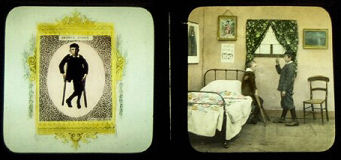 Unarguably it was the 5000 who were the Army’s audience: 5000 people from all
classes and inclinations … There was a stream of true worship amongst the
attentive crowd. All eyes were glued to the screen, on which appeared sad,
solemn and rejoicing scenes from both heaven and earth. Portraits of the
Commander and the Marechal were shown as introductions, time and again greeted
with applause and amen. Then were shown the first stories, which were so moving
because of their portrayal through the slides. First came the story of the
Little Match Girl, so horribly sad. Then follows the story of the crippled boy,
the child and the drunk. He falls in the water and is, barely alive, brought to
the hospital … he briefly regains consciousness. And when he sees the bright,
warm room and such friendly faces he thought, the little he knew of Heaven, that
he was there and says to the doctor: “Are you God?” … Whilst the immense crowd
watches this moving death scene in silence, the voice of the Commander raises:
“According to the average annual death toll approximately hundred people present
here this evening will die before the end of this year. You, who are here
listening to me, you may be one of them. Are you prepared to die?”. This
poignant and grave thought spoken under such a profound silence, in the darkness
of the hall only lit by the deathbed scene on the screen, made an impression
beyond words … From time to time a hymn appeared on the screen which the
children sung alone or were joined by the entire audience…..
Unarguably it was the 5000 who were the Army’s audience: 5000 people from all
classes and inclinations … There was a stream of true worship amongst the
attentive crowd. All eyes were glued to the screen, on which appeared sad,
solemn and rejoicing scenes from both heaven and earth. Portraits of the
Commander and the Marechal were shown as introductions, time and again greeted
with applause and amen. Then were shown the first stories, which were so moving
because of their portrayal through the slides. First came the story of the
Little Match Girl, so horribly sad. Then follows the story of the crippled boy,
the child and the drunk. He falls in the water and is, barely alive, brought to
the hospital … he briefly regains consciousness. And when he sees the bright,
warm room and such friendly faces he thought, the little he knew of Heaven, that
he was there and says to the doctor: “Are you God?” … Whilst the immense crowd
watches this moving death scene in silence, the voice of the Commander raises:
“According to the average annual death toll approximately hundred people present
here this evening will die before the end of this year. You, who are here
listening to me, you may be one of them. Are you prepared to die?”. This
poignant and grave thought spoken under such a profound silence, in the darkness
of the hall only lit by the deathbed scene on the screen, made an impression
beyond words … From time to time a hymn appeared on the screen which the
children sung alone or were joined by the entire audience….. |
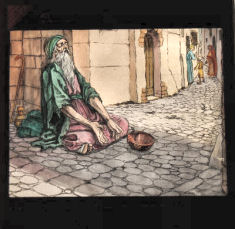 ... And Jesus answered and said unto him, What wilt thou that I should do unto thee? The blind man said unto him, Lord, that I might receive my sight. And Jesus said unto him, Go thy way; thy faith hath made thee whole. And immediately he received his sight, and followed Jesus in the way. (Mark 10) |
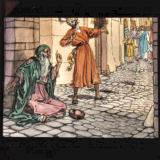 |
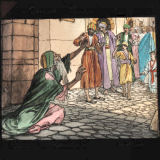 |
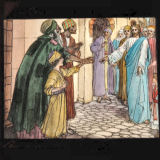 |
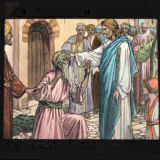 |
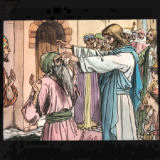 |
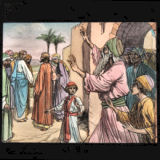 |
|
The headquarters of the Dutch Salvation Army possess an index of lantern slides, dating from 1902. From this may be concluded that the Army at this time hired out a few hundred slide series. The index entails biblical series and other religious themes, a lot of hymn text slides, a large amount of stories dealing with the vice of intemperance and the joy of temperance; Father Come Home, The Drunkard’s Children, A Pair of Shoes, The Drunkard’s Wife, The Drink Fiend to name a few. Besides that, it lists series about other countries and other people, about shipwrecks and a fair amount of photographic slides of the Dutch Royalty. Furthermore there are many life model series and, often comic, children’s stories produced by the English firm Primus. And last but not least of course series about the Salvation Army’s Land and City Colonies and related social work. |
|
TEN NIGHTS IN A BAR ROOM English series of 'Temperance-slides" used to be a warning against the abuse of alcohol. |
||
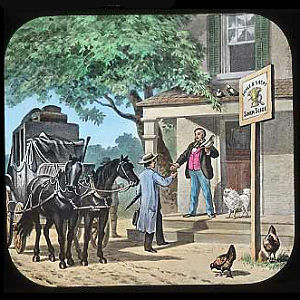 |
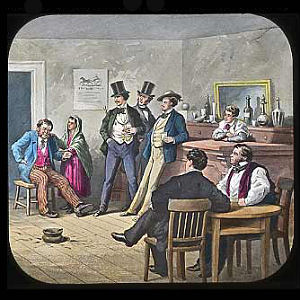 |
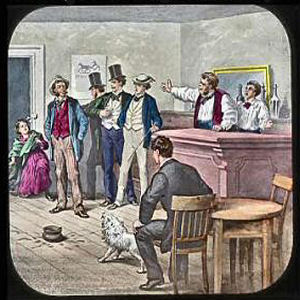 |
| 1. The Arrival at the "Sickle and Sheaf" | 2. Joe Morgan's little Mary begs him to come home | 3. Slade throws glass at Joe Morgan and hits Mary |
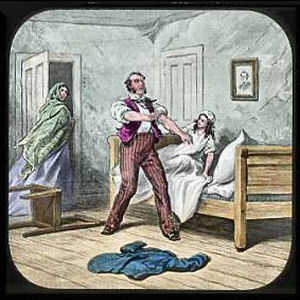 |
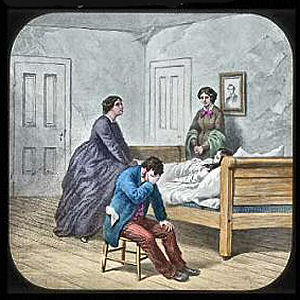 |
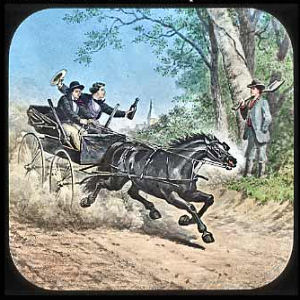 |
| 4. Joe Morgan suffering the horrors of Delirium Tremens | 5. Death of Joe Morgan's little Mary | 6. Frank Slade and Tom Wilkins riding off on a spree |
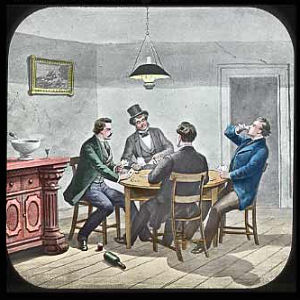 |
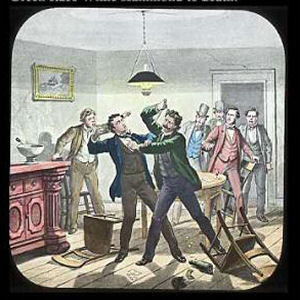 |
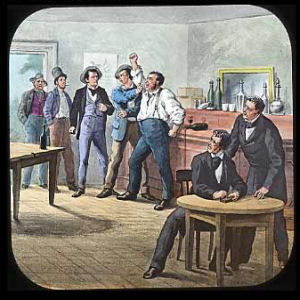 |
| 7. Willie Hammond is induced by Harvey Green to gamble | 8. Harvey Green stabs Willie Hammond to death | 9. Quarrel between Slade and his son Frank |
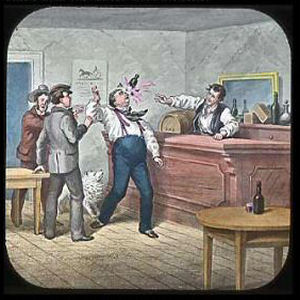 |
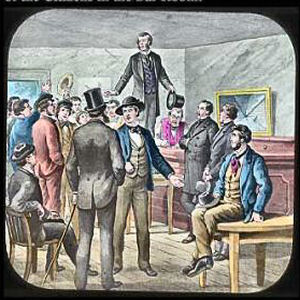 |
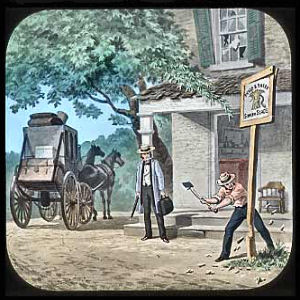 |
| 10. Frank Slade kills his father with a bottle | 11. Meeting of the citizens in the Bar-Room | 12. The Departure from the "Sickle and Sheaf" |
|
The first Open Air lantern screening organised by the Salvation Army was to take place in the city of Utrecht in 1911. The grand presentation was coinciding with the last day of the weeklong fair, to counteract the poisonous entertainment of the fair. A lively description sets the tone: |
||
|
And again there was the Fair. What to do to keep the crowds away and also preach the Gospel? …
Thus we wished on this
Saturday night to hold a Music and Song gathering on the Oudegracht (Old Canal),
right in the centre of Utrecht, lasting from eight till half past nine, to be
followed by a Lantern Presentation, from half past nine till eleven, using a screen
stretching across the entire width of the canal. The rope carrying the screen
hung nearly nine meters above the ground, the height of a formidable house … The
electric Lantern would be placed on the Bezembrug (Broom Bridge), on top of a
four or five meters high assembling truck, owned by the Electric Power Plant.
Everything went smoothly. The shops in the surrounding area were willing to turn
off their illumination. Even the Cinema theatre FLORA. No one turned us down. The evening came. The music band and the choir performed a beautiful programme. Around nine o’clock a mass of people had flocked, and it kept growing. The large projection screen was hoisted in position. The tension mounted. The shops dimmed their lights. The large screen measuring five by six meters was translucent and the texts done in normal mirror writing to make them readable from both sides. 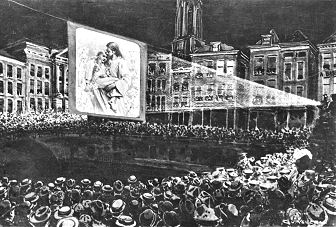 The first images appeared. Not
quite sharp yet (in focus), but gradually improving and after about a quarter of
an hour a good and clear image. First flowers to which the music band played
“God is Good”. The choir sang. Followed by slides of the Royal Family under loud
cheers. The band played whilst the choir sang the patriotic ‘Wien Nederlandsch
Bloed’ (Who has Dutch blood …) Next: nature scenes and images of the sea. Each
new section was announced on the screen. Furthermore slides illustrating: Er
ruischt langs de wolken (Whispering through the clouds) and more people
joined in the singing. It should not be forgotten that the space around the
canal is enormous and it is inconceivable to have a lecture accompanying the
slides. Next a series of images full of the misery induced by drink, when the
music band plays “O Zwerv’ling!” (Oh Wanderer Orphan) and the choir sings. This
series was finished with: “O Vader kom thuis” (Oh father come home). After that:
“Het verloren schaap (the lost lamb)”, ten slides depicting the known story,
whilst the choir sang: “Daar zijn negenennegentig veilig thuis” (There are
99 safely home). Impressive! The finish showed “Dat’s Heeren zegen op U daal” (will the
blessing of the Lord be upon you). By now it was a quarter to eleven and more
then hundred and fifty slides had been shown. The first images appeared. Not
quite sharp yet (in focus), but gradually improving and after about a quarter of
an hour a good and clear image. First flowers to which the music band played
“God is Good”. The choir sang. Followed by slides of the Royal Family under loud
cheers. The band played whilst the choir sang the patriotic ‘Wien Nederlandsch
Bloed’ (Who has Dutch blood …) Next: nature scenes and images of the sea. Each
new section was announced on the screen. Furthermore slides illustrating: Er
ruischt langs de wolken (Whispering through the clouds) and more people
joined in the singing. It should not be forgotten that the space around the
canal is enormous and it is inconceivable to have a lecture accompanying the
slides. Next a series of images full of the misery induced by drink, when the
music band plays “O Zwerv’ling!” (Oh Wanderer Orphan) and the choir sings. This
series was finished with: “O Vader kom thuis” (Oh father come home). After that:
“Het verloren schaap (the lost lamb)”, ten slides depicting the known story,
whilst the choir sang: “Daar zijn negenennegentig veilig thuis” (There are
99 safely home). Impressive! The finish showed “Dat’s Heeren zegen op U daal” (will the
blessing of the Lord be upon you). By now it was a quarter to eleven and more
then hundred and fifty slides had been shown. The message got through to thousands of people. They even speak of ten thousand. It was a real clean out of the fair ground, an attempt to depopulate these places of temptation … It was also a powerful demonstration for the Gospel … |
| |
©1997-2023 'de Luikerwaal' All rights reserved. Last update: 19-08-2023. |